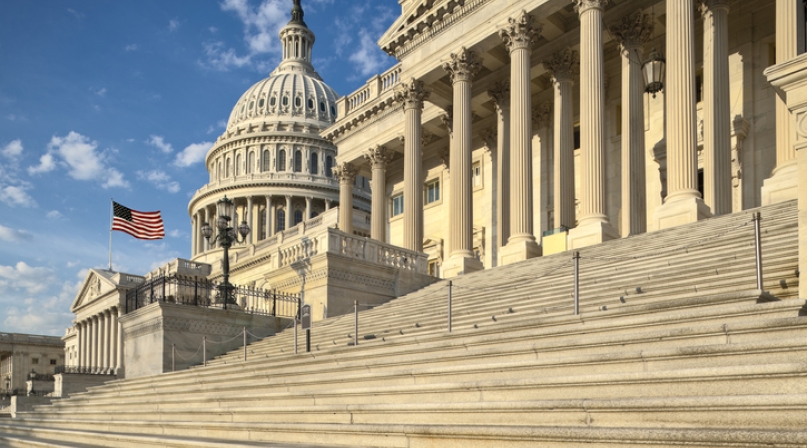Inflation Reduction Act signed into law
Author

Paige Mellerio

Blaire Bryant
Upcoming Events
Related News

Key Takeaways
On August 16, President Biden signed the Inflation Reduction Act (IRA) into law. The IRA, which aims to reduce the federal deficit, cut carbon emissions and address several issues related to healthcare, is the product of months-long negotiations between Senate Majority Leader Chuck Schumer and Senator Joe Manchin following the passage of the Build Back Better Act (BBBA) in the U.S. House of Representatives last year.
According to an estimate from the nonpartisan Congressional Budget Office (CBO), the IRA would reduce federal deficits by $102 billion between 2022 and 2031 - the lifespan of the bill - through the implementation of measures intended to reduce inflationary pressures.
In addition to addressing the federal deficit, the IRA aims to reduce carbon emissions by 40 percent below 2005 levels by 2030. It does so by making significant investments in climate and environment programs and providing tax incentives to boost the development and deployment of clean energy. Many of these programs include direct funding opportunities for counties, who play a crucial role in responding to climate change and reducing national emissions levels through the deployment of clean energy. Many engage and partner with local utilities in energy planning, including utility-scale renewable energy projects, key regulatory issues, grid modernization and storage and energy assurance strategies.
Further, the legislation includes several measures related to healthcare, including capping out-of-pocket costs of prescription drugs for Medicare beneficiaries each year at $2,000.
Key provisions for counties include:
ENVIRONMENT, ENERGY AND LAND USE PROVISIONS
The IRA makes significant investments in energy and climate. The legislation would:
- Extend the investment tax credit (ITC) and the production tax credit (PTC) for projects that begin construction prior to January 1, 2025. The PTC is a per-kilowatt-hour (kWh) federal tax credit for renewable electricity generated by both private and public entities. The ITC creates a tax incentive for project owners or investors, which can include counties, to generate energy from renewable sources. The IRA further allows state and local governments, among other eligible entities, to receive direct payments from the federal government instead of the ITC or PTC.
- Extend the carbon capture and sequestration (45Q) tax credit to projects that begin construction prior to January 1, 2033. The legislation would also lower the carbon capture thresholds required to qualify for the credit.
- Decrease the maximum value reduction of 45Q tax credits when used in conjunction with tax-exempt bonds from 50 percent to 15 percent. This decrease could make the new carbon capture bonds established in the Bipartisan Infrastructure Law more attractive and feasible for counties. The IRA further allows state and local governments to receive direct payments from the federal government in lieu of the credit.
- Establish several grant programs at the Environmental Protection Agency (EPA) and other agencies to reduce emissions across a range of sectors. Counties would be directly eligible to apply for funding under many of these programs, including a $3 billion competitive grant program to reduce air pollution at ports and a $7 billion competitive grant program to provide financial assistance to low-income and disadvantaged communities to deploy or benefit from zero-emission technologies.
- Establish a $3 billion Neighborhood Access and Equity Grant program at Federal Highway Administration (FHWA) to improve walkability and safety, mitigate negative environmental impacts and support planning and capacity-building activities in disadvantaged communities, including counties. Counties, which play a significant role in making communities safer and more walkable and accessible, would apply directly to the Department of Transportation for funding under the program.
- Require the Department of Interior (DOI) to hold an onshore oil and gas lease sale within 4 months of issuing new onshore wind and solar rights of way. It would also require DOI to hold an offshore oil and gas lease sale of at least 60 million acres in the year prior to issuing offshore wind leases. Counties support increased oil and gas production in a way that maximizes the funding streams of the royalty revenue for the purposes of conservation, recreation, restoration and protection of vital national resources.
- Provide $5 billion in grants to support collaborative vegetation management, reforestation and hazardous fuels reduction projects to improve the health of federal and non-federal forestlands. Counties play an active role in protecting the health of forests through robust vegetation management.
FINANCE AND TAX PROVISIONS
The IRA is projected to reduce deficits through the relief of inflationary pressures. These offsets include two major tax provisions:
- Strengthening the Internal Revenue Service’s (IRS) tax enforcement and compliance abilities by providing $80 billion for IRS taxpayer services, enforcement efforts, operations support and business systems modernization.
- A 15 percent alternative minimum tax (AMT) for corporations with profits of more than $1 billion. This provision would become effective beginning in the 2023 taxable year and includes an exemption for businesses owned by private equity.
Of particular note to counties, however, unlike the Build Back Better Act, the IRA does not include relief from the $10,000 cap on the state and local tax (SALT) deduction enacted in the 2017 Tax Cuts and Jobs Act. The House-passed bill would have raised the SALT cap to $80,000 and would have extended the cap past its 2025 expiration date as a spending offset. NACo supports the full deductibility of all state and local taxes, particularly the property tax, in the federal tax code.
HEALTH PROVISIONS
The IRA includes several provisions related to healthcare that would impact counties, including:
- Caps out-of-pocket cost of prescription drugs for Medicare beneficiaries each year at $2,000. As owners and operators of the systems of care in our communities, counties support a variety of strategies to assist in cost containment for prescription drugs. Seniors and individuals with disability who are able to receive prescription drugs at a reduced rate under Medicare are more likely to have better health outcomes and less likely to be admitted into county health facilities such as hospitals and the emergency room.
- Provides free vaccines for Medicare beneficiaries which include COVID-19 vaccines, shingles and other necessary vaccines. Counties, as key providers of local public health services and frontline service providers for the medically vulnerable, continue to administer essential vaccinations to residents, regardless of their insurance status. Federal support for the cost of administering COVID-19 vaccines and other important vaccinations increases communal protection from infectious diseases while decreasing the cost burden on counties of uncompensated medical care.
- Extends Affordable Care Act (ACA) premium subsidies to 2025, which assist low-income individuals with obtaining health insurance on the ACA marketplace, by capping how much an individual pays out of pocket for insurance based on their income level. Important for counties, these subsidies allow low-income individuals to obtain affordable health insurance based on their income, reducing the number of uninsured and medically indigent individuals seeking care in county health facilities. The subsidies are set to expire at the end of 2022 and would be extended for three years under this bill.
Notably, unlike the Build Back Better Act, IRA does not include the enactment of the Medicaid Reentry Act which amends the Federal Medicaid Inmate Exclusion policy (MIEP) by authorizing incarcerated individuals to receive services covered by Medicaid 30 days prior to their release from jail or prison.
Resource
Legislative Analysis for Counties: The Inflation Reduction Act

Related News

USDA and HHS release new dietary guidelines
On January 7, U.S. Department of Agriculture Secretary Brooke Rollins and U.S. Department of Health and Human Services Secretary Robert F. Kennedy, Jr. unveiled the new Dietary Guidelines for Americans, 2025–2030.

Congress examines PFAS liability and cleanup regulations
On December 18, the U.S. House Energy and Commerce Subcommittee on Environment held a hearing examining the current statutory and regulatory landscape for PFAS. The hearing follows a similar hearing held by the U.S. Senate Environment and Public Works Committee on November 19.

SAMHSA cancels, reinstates thousands of behavioral health grants
Late on Wednesday, January 14, the Administration announced that thousands of Substance Abuse and Mental Health Services Administration (SAMHSA) grants that had been terminated just one day earlier would be reinstated.
